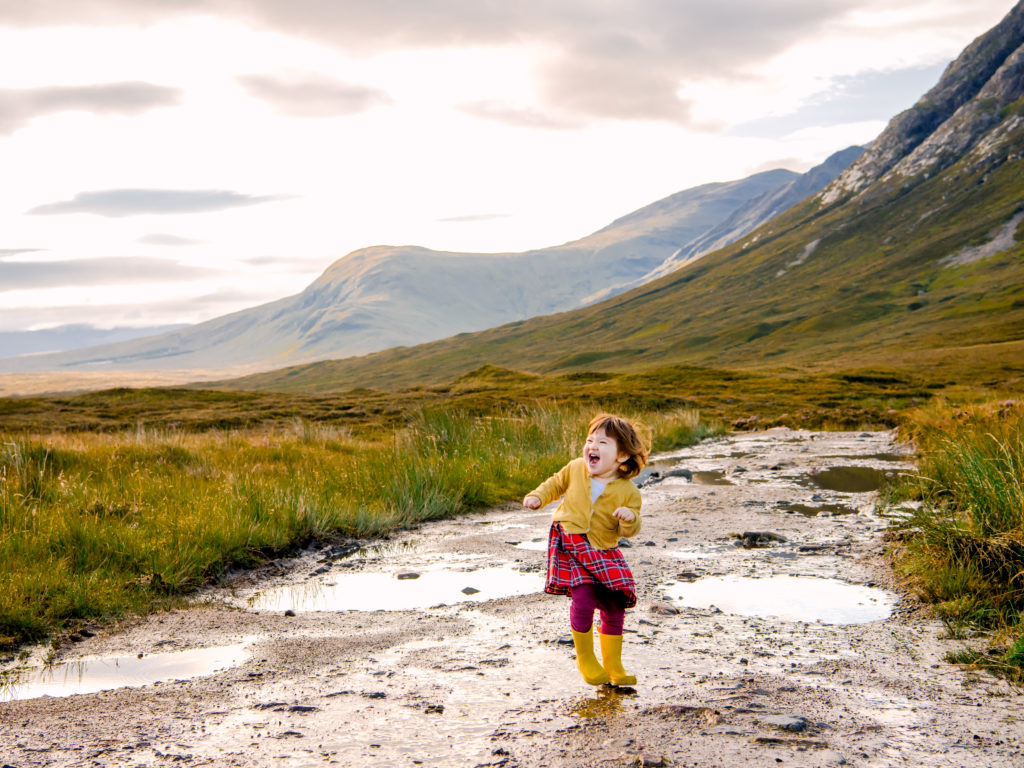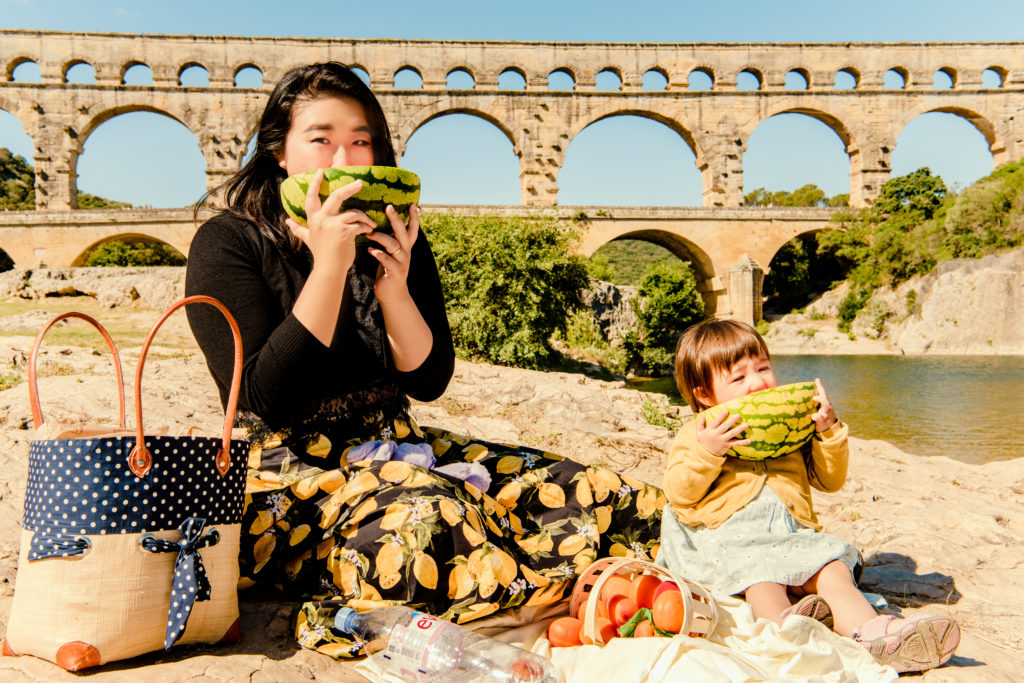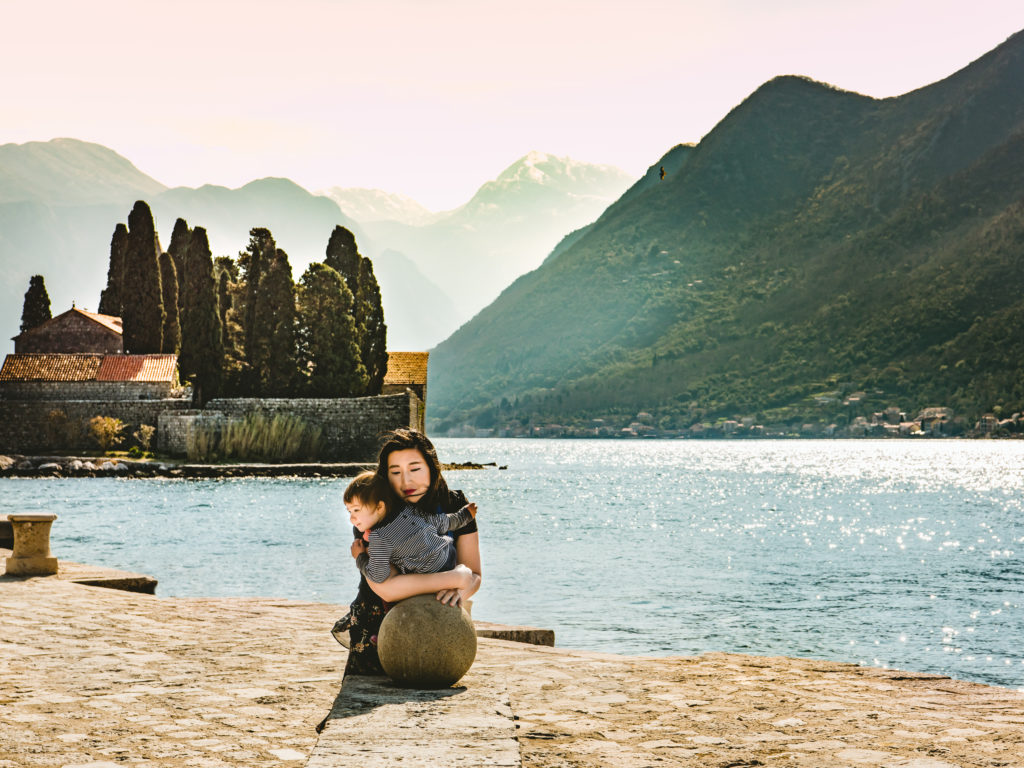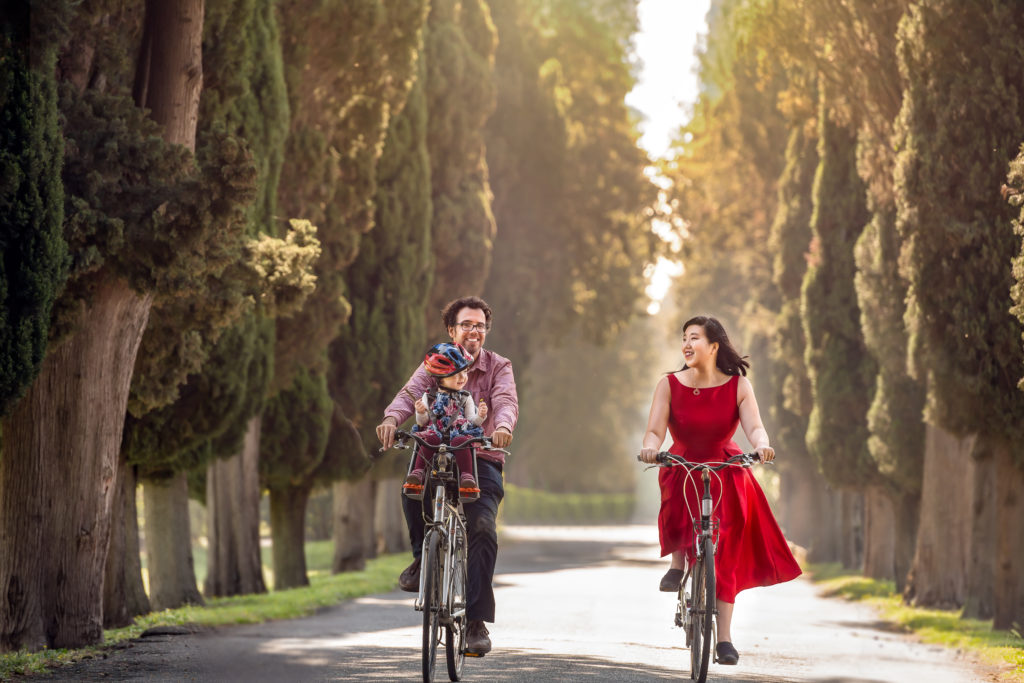We’ve got an awesome guest post written by Jake and Dannie, who are professional photographers and family travel bloggers. They are sharing 10 of their best tips for how to take amazing outdoor travel photos!
1. Go for Golden Hour, not Sunset
Because sunrises and sunsets are so pretty, a lot of people will try to take their family photos just as the sun is dropping below the horizon. Though the sky is colorful at that moment, it actually creates very challenging light for photographing people. The best time for photography is in the hour or two before sunset or after sunrise. At this time, the light will shift to a golden color that will cast beautiful shadows and make the hair glow.

Golden hour at Aqueduct Park in Rome, Italy
2. Compose the Scenery First
The scenery isn’t likely to change much while you’re taking pictures, so get that squared away first. If you are following the kids around with the camera, you are leaving the scenery to luck. You’ll get much better shots by picking your angle ahead of time and then encouraging the family to move into your composition. The less time the kids have to spend posing while you hop around adjusting the background, the happier everyone will be.

Lady in red at Kotor, Montenegro
3. Mind Your Shutter Speed
Long exposures are great for misty waterfalls and night skies, but when you are photographing a family on the go, you don’t want to get home and zoom in on a lot of blurry faces. Generally speaking, you’re a lot better off with noise than motion blur, so bump up that ISO when you are in deep shade or low lighting conditions. In case you are unfamiliar with what ISO means, ISO measures the sensitivity of the image sensor.
The lower the ISO number the less sensitive your camera is to light and the finer the grain. The higher the ISO, the more sensitive the sensor becomes, and the brighter the image will appear. There is no “correct” ISO, you will have to make your best guess based on how dark the scene looks, and then make adjustments as needed. Right after sunset I usually assume that the ISO needs to be at least 2000 (such as the photo pictured below).

Walking the streets of Paris in low-light
4. Don’t Use Auto White Balance
Sure, your camera can do an okay job guessing what color and light you are dealing with. But you’ll find in a lot of situations, small changes in the scenery or composition can change that guess from shot to shot, even when nothing has really changed. If you change the settings in your white balance depending on the lighting situation (for example, use the setting for cloudy skies if it’s overcast), you will avoid small shifts in tone and temperature from shot to shot. Simply put, white balance in digital photography means adjusting colors so that the image looks more natural.
To change the white balance in Lightroom, select your image and go into Develop Mode. In the sidebar on the right, Basic adjustments will be the first category and White Balance is the first adjustment you will see. You can try sliding the tint and temperature around until it looks right, but there is usually an easier way. If there is something in your image that you know is supposed to be white, click on the eyedropper tool and then click on the white part of the image.
Lightroom will then automatically adjust the entire image so that the white balance is correct. You can also select from the white balance presets (like shady, sunny, etc) and then fine tune it using the sliders. Once you have the right white balance for the first image, you can copy and paste it, along with any other adjustments you have made, onto the other images in the set.
5. Protect Your Gear

Shooting in moody weather in Glencoe, Scotland mountains
The outdoors is where weather lives! Rain, snow, sand, and even bird poo can turn your new camera into an expensive paper weight. A rain cover for your backpack is a great idea, but if you don’t have one, I recommend wrapping your camera up in multiple plastic bags. In the past, I’ve tried dry bags while kayaking, but be careful on humid days because condensation can form on the inside of the bag. You can also try doubling up on dry bags, as this ensures your camera equipment stays dry and condensation-free.
6. Get Front and Center With a Wide Angle
Sometimes there’s so much scenery that only a wide angle lens can capture it all. The downside of wide angle lenses is that they distort the image so that objects closer to the center of the image look farther away. Make sure you are close enough to the kids, so that they don’t look like little ants in the distance. Also, try your best to get everyone as close to the center of the frame as possible in a wide angle photo, since heavy distortion can make people look stretched out near the edges.

Playing in puddles in Glencoe, Scotland
7. Interact With The Environment
You didn’t climb up that mountain to grin awkwardly into the camera. Whether your family likes to play a game, set up a picnic or just strike a triumphant pose, make sure you get some photos of everyone being themselves in the moment. Those candid shots will always be your favorite.

Enjoying a picnic at Pont Dugard
8. Get Creative With Lighting
Sometimes backpack space is at a premium and the lighting gear just isn’t worth carrying. But there are still a lot of ways to improve your photos when the light gets spotty. On a sunny day, you can make a bounce light out of any reflective surface, like a shiny emergency blanket, the tinfoil from your sandwich, a white hoodie, or even a big, light colored rock (just avoid colorful bounce lights that can cast a funny hue on the subject). We’ve also lit photos with car headlights, flashlights and lanterns (but once again, watch your shutter speed).
9. Try a Silhouette
So the golden hour light has passed, and the sky is a lovely sheet of purple. It’s time to go for a silhouette. The key here is to forget about all the details and only think about the profile of your subjects. Make sure that there are no objects like trees or bushes intersecting their figures against the open sky. Next, ensure that they are posing so that all the information that needs to be captured could be seen by tracing their edges with your finger. Even if you can see their faces, the camera won’t. Their outline is all that matters. Now, just expose for the sky, and try out a few different poses.

Taking a sunset walk in Zukovica, Montenegro
10. Be Safe
Everyone wants to come home with a unique and exciting photo, but that’s no excuse to do something that jeopardizes what’s most important to you. No photo is worth risking a nasty fall, catching hypothermia, or approaching wild animals. There’s plenty to see out there in the wild, so make sure your whole family has a lot to smile about on this adventure and the next!

Keeping the little one safe from falling in the water at Perast, Montenegro
About Jake and Dannie:
Jake and Dannie are two professional photographers who put their business on hold to explore the world with their daughter, Lisa. She was one year old when they left and now she’s two, and they expect her to turn three next year while they are traveling in China. They are slow traveling, staying in each place they visit for a month at a time or more, getting to know their surroundings and creating the images they’ve always wanted. Their biggest outdoor adventure so far has been tent camping for three months in the highlands of Scotland, but their daughter’s first hike was in the gorgeous mountains over Kotor, Montenegro.
You can follow their journeys on their slow travel blog, or follow their adventures and see their beautiful captures around the world on Instagram.
